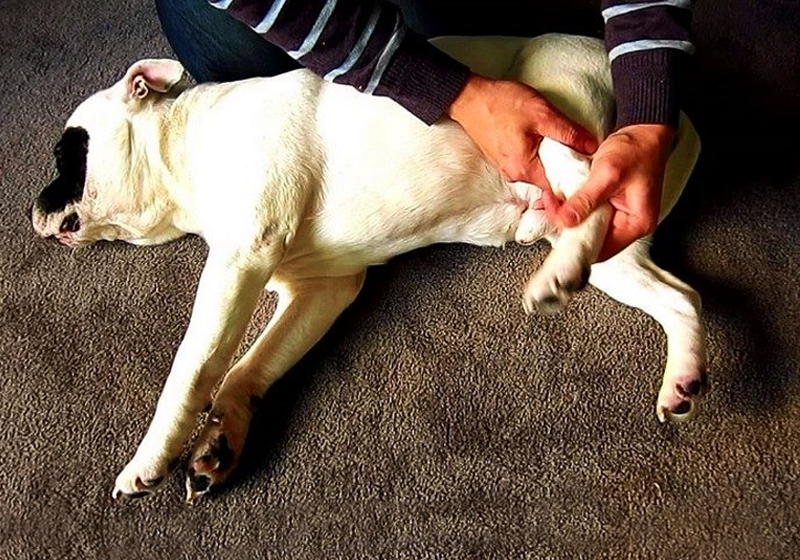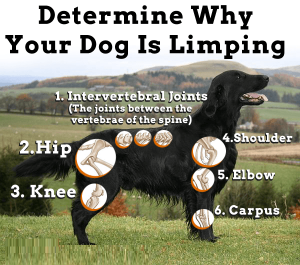
Limping in dogs is a known and commonly observed phenomenon. Many times, you must have observed that your dog might fall off while playing or hit something on his legs. This slows down his movement and he begins to limp. The difficulty the dogs face in walking with damaged legs is far worse than we can imagine. These accidents and incidents happen all of a sudden without any warning.
Noticing signs and recognizing symptoms when dog is limping is essential because it may help you find out the exact reason why the dog is limping.
Signs like swelling, weakness in muscles, muscular pain, bruising, reduced mobility are some major key points that helps in detecting whether your dog is limping or not.
What might cause limping in the dogs? Just accidents or injury? No, there’s more to the causes. Let’s find out.
Main Causes of Dog Limping

Bone or Joint Problem in Dogs
There are many joints in dog’s body. The 3 important joints in the front limbs are the wrist, elbow and shoulder and in the hind legs are ankle, knee and hip. By applying a little pressure, you can know whether there are any inflamed joints or not. There are also a number of bones in a dog’s body, which can be fractured and bruised resulting in limping.
Injuries including cuts and burns in dogs
- Sprains
Sprains are most common form of injury in pets, especially when your dog is quite active in running and other mobile activities. The behavioral change and less outdoor activities indicate that the dog might be limping. The injured portion can be carefully covered with a cloth and the dog can be taken to vet for further examination.
- Fractures in Dogs
Your dog can hurt his limbs severely if gotten into an accident. Always be very careful while walking your dog or travelling with him and make a habit of leashing him when going out. Fractures in bones of dogs can cause great deal of pain and limping. Bone fractures need to be examined and treated by a vet only.
- Dislocations in Dog’s Joint
Dislocation in dogs is a frequent cause of limping. Dislocation may occur due to an accident when a car hits your pooch or when he falls off from a place at height. The dog at this point suffers from an immense unbearable pain and is not able to stand on his limbs. Any amount of small weight on the limbs may even result in severe injuries. Immediately take your dog to a vet if such situation occurs.
- Ruptured ligament
Another common and major reason of injury is a ruptured ligament, which makes the dog limp. Young and active dogs may be at the target as they are very energetic and move around a lot. Usually a ruptured ligament is healed in a few days. In these few days, the dog must rest completely because if he not healed properly it might cause trouble later.
- Back injuries in Pets
A number of times it may happen that the spinal part of the dog is injured in an accident. The pain that the dog suffers when the injury is in the neck and back is insufferable. The dog should be instantly rushed to a vet for treatment to protect your dog’s spine from collapsing and paralysis.

Reasons other than injury in Dogs
- Dog’s Bone tumors
Also known as, osteosarcomas, tumors mostly occur in large-breed dogs. There may or may not be signs of inflammations. However, if you press on the bones, it might induce pain in the dog. The degree of the pain lets you know the proper treatment. Vet’s advice is necessary in this case.
- Degenerative Joint Disease of Dog
Also called as arthritis or osteoarthritis, is a common issue in old age dogs. Although now a days, many medications are available to treat arthritis and reduce joint pains cause due to it. It also improves the mobility of the dog. However, the limping might persist at a lower level.
- Lyme Disease in Dogs
Lyme disease is a well-known tick-borne disease that infects dogs. As it turns out, this disease can cause limping in dogs and the joints may become swollen and painful. This condition may last for a few days while limping might even last for a few months. Other symptoms that depict the presence of Lyme disease are loss of appetite, fever and lethargy.
Limping conditions can range from minor to severe depending on the causes. Determining the symptoms and that your dog does have limping problem, you must consult a vet. For non-emergency limps, you can:
- Remove and clean foreign particles of you notice them in between the toes of the pets.
- In case of cut or torn foot and broken toenails, try to control the bleeding, use first aid, and consult a vet.
- Confine lame dogs to restrict their movement and other activities.
- If there is an abscesses present, soak a cloth in warm water and apply on it. If the abscesses ruptures, then take your pet to the vet and get it cleaned.
- If any swelling is there on the dog’s legs, apply ice bags to improve the health.
In case your dog is suffering from immense pain and crying or the degree of injury is very severe, immediately take him to a vet.
